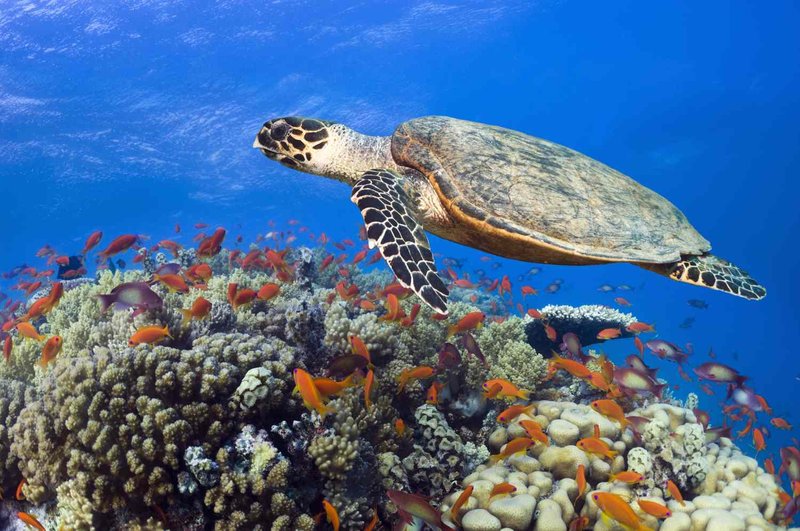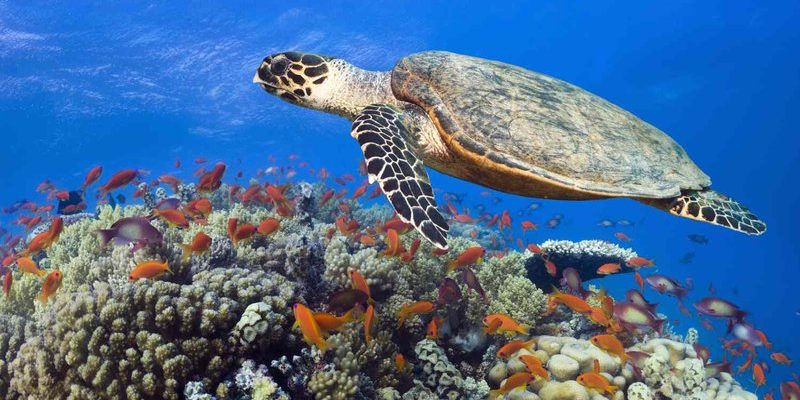
So, why does their habitat matter? Well, understanding where these turtles are found helps us appreciate their role in marine ecosystems. Hawksbills are critical players in coral reef health, as they help maintain the balance of the underwater food chain. Let’s dive in and explore the various places where hawksbill turtles call home.
The Perfect Ocean Home for Hawksbill Turtles
Hawksbill turtles are true ocean enthusiasts. They typically prefer warm, shallow waters found in tropical and subtropical regions. You can often spot them around coral reefs, which are like their bustling cafés, teeming with food and friends. These areas provide plenty of opportunities for hawksbills to feast on their favorite snacks—sea sponges, jellyfish, and various kinds of algae.
One of the most famous hotspots for hawksbills is the Caribbean. Here, crystal-clear waters are the stage for these turtles to thrive. Just imagine them swimming lazily through the vibrant coral gardens, their beaks delicately picking apart the sponges. But it’s not just the Caribbean; they can also be found along the coastlines of the Indian Ocean and the Pacific, where the warmth and rich biodiversity support their needs.
If you’re thinking they might venture into cooler waters, think again. Hawksbills tend to avoid those chilly regions. Their bodies do best in warmer environments, which means you won’t find them lounging around in places like the Arctic. They really are picky swimmers when it comes to temperature!
Coral Reefs: A Hawksbill’s Favorite Restaurant
Let’s talk about coral reefs a bit more, since they play such a significant role in hawksbill turtles’ lives. Coral reefs are not just stunning underwater landscapes; they’re like bustling cities for marine life. In these reefs, hawksbills find a smorgasbord of food. Imagine walking into a restaurant where everything on the menu is your favorite dish—that’s how hawksbills feel about coral reefs!
These turtles have specially adapted beaks that allow them to reach into crevices of the coral to find their meals. This unique feeding habit not only nourishes the turtles but also helps maintain the health of the coral by preventing overgrowth of sponges. It’s a win-win situation!
However, not all coral reefs are created equal. In places where pollution or climate change affects the reefs, hawksbill populations can decline. That’s why preserving these delicate ecosystems is so crucial. The survival of hawksbill turtles is tied directly to the health of coral reefs around the world.
Hawksbill Turtle Nesting Grounds
While hawksbill turtles spend most of their time in the ocean, they also have important nesting sites. These turtles typically return to the same beaches where they were born to lay their eggs, creating a special connection to these areas. Imagine going back to your childhood home; that’s the kind of loyalty they show!
Nesting generally occurs along sandy beaches in tropical areas. Some of the most well-known nesting sites include the islands of the Caribbean, parts of the Seychelles, and beaches along the Great Barrier Reef. Hawksbills prefer solitary nesting, so you’ll often find only one turtle at a time laying her eggs, digging nests in the sand, and covering them up.
You might wonder why these nesting sites are crucial. Well, the survival of the next generation of hawksbills depends significantly on the safety of these beaches. Unfortunately, coastal development and human activities can threaten these nesting grounds. Protecting these beaches is essential to ensure that future hawksbill generations can flourish.
Hawksbill Turtles and Coastal Ecosystems
Hawksbill turtles don’t just hang around the ocean—they’re integral to coastal ecosystems too. They help maintain the health of your favorite beaches and coastal areas. When hawksbills feed on sponges, they help control the population of these organisms, which keeps the coral reefs healthy.
Coastal areas provide important habitats for hawksbills, especially in mangroves and seagrass beds. These environments serve as nursery grounds for young marine life, offering protection from predators. Young hawksbills often take refuge in these habitats until they’re big enough to venture into deeper waters.
By maintaining a balance in these ecosystems, hawksbill turtles contribute to biodiversity. If their numbers decline, other species can also suffer. It’s like a domino effect that can disrupt the whole coastal community. Protecting hawksbills means protecting the vibrant life all around them.
Why Conservation Matters for Hawksbill Turtles
Conservation efforts are vital for the survival of hawksbill turtles, which are critically endangered. Various factors threaten their existence, such as habitat loss, illegal hunting, and climate change. It’s like trying to save a rare classic car—the more people who cherish and protect it, the better chance it has to survive.
Organizations worldwide are working to protect hawksbills by preserving their habitats, conducting research, and raising awareness. For example, beach clean-up initiatives help keep nesting sites safe, while legislation against illegal hunting helps protect these magnificent creatures from poaching.
You can also play a role in conservation. Supporting organizations dedicated to marine life and being mindful of your impact on the environment can contribute to the recovery of hawksbill populations. Every little bit helps, and together, we can make a significant difference.
Hawksbill turtles are fascinating creatures that play a vital role in our oceans and coastal ecosystems. From their vibrant habitats in tropical waters to their pivotal place in coral reef health, they truly showcase nature’s beauty. They remind us of the interconnectedness of life and the importance of protecting fragile ecosystems.
By understanding where hawksbill turtles are found and the challenges they face, we can all contribute to their conservation. Whether it’s promoting awareness, participating in local clean-up efforts, or simply spreading the word about their significance, every action counts. Let’s cherish and protect these beautiful turtles and ensure that they continue to grace our oceans for generations to come!

